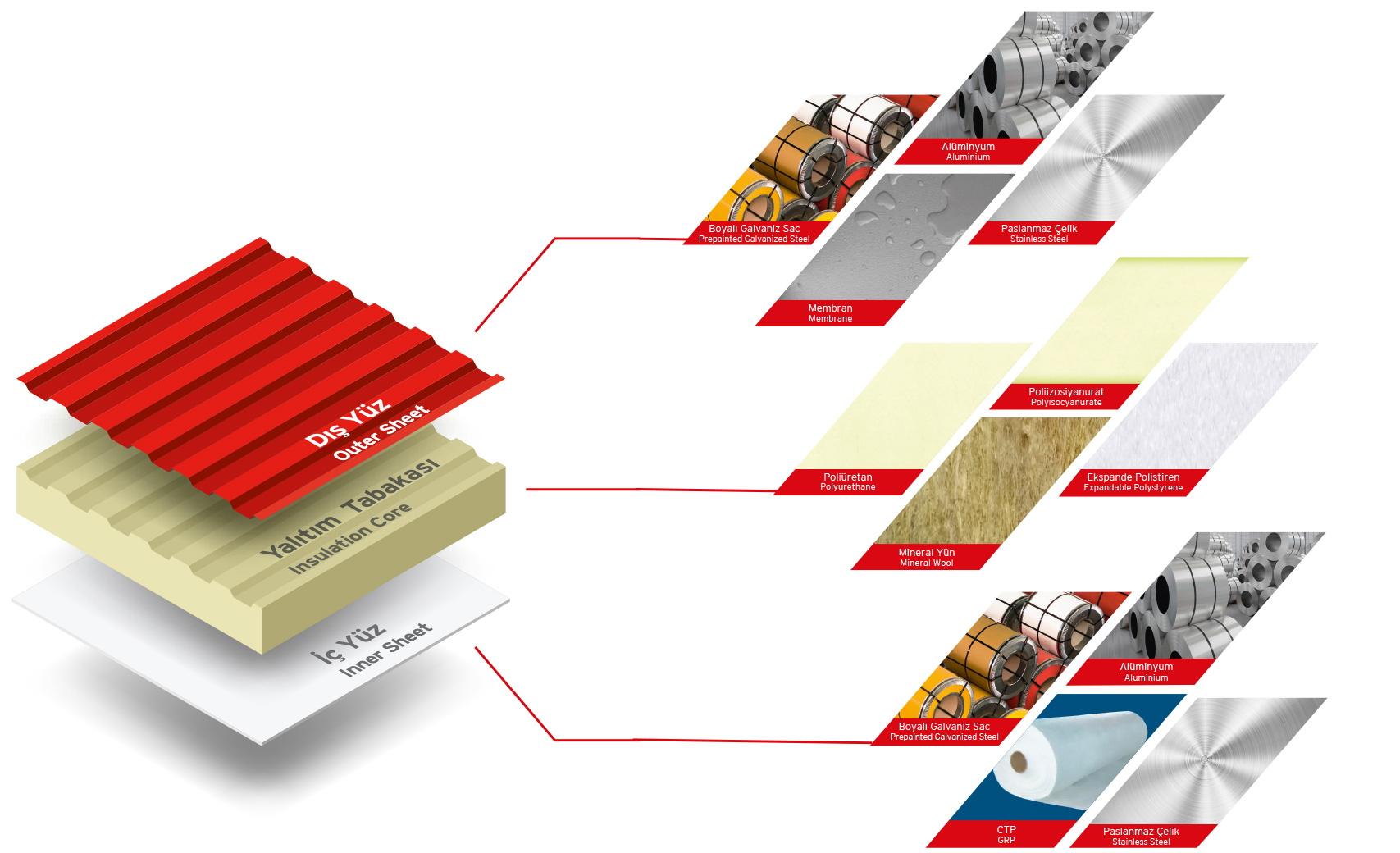About Sandwich Panels
What is Sandwich Panel?
Sandwich panel is a system that protects the buildings from external factors and provides the utmost convenient and economical solution for them to have a powerful stand. As modern, light and durable construction elements, sandwich panels are used to clad roofs and external walls of the buildings as well as achieving insulated internal walls and cold storages.
Sandwich panels, protecting you against the external factors on all sides of your building, are produced by filling in a thick and low density insulation material between two thin and high density metal surfaces. These ready-assembled building elements, which have a high load carrying capacity despite their own low weight, are produced on continuous lines.
Different insulation materials should be chosen according to the needs of the buildings. Sandwich panel production is made in all insulation types including PUR, PIR, Mineral Wool and EPS. You can decide which type of sandwich panel is suitable for your building/project by taking into consideration the thermal, humidity, sound insulation and fire resistance needs of thereof.
Sandwich panels are generally used in industrial facilities, commercial buildings, cold storages, residential buildings, power plants as well as buildings for agricultural and husbandry.
The Life of Sandwich Panel
Sandwich panel, which is a composite material, is formed by filling insulation material between two metal surfaces.
The longevity of sandwich panels depends on designing to choose the right technical specification of product components according to the needs of the building, the environment and climate conditions in which it is located.
Outer sheet of the sandwich panel should be resistant to temperature changes, UV rays and external effects. The inner sheet should be resistant to chemical and physical effects as well as condensation, which may result from the inner atmosphere of the building.
Moreover, the load carrying capacities of sandwich panels, designed with the insulation material matching the needs of the building, must be calculated correctly based on the load they will carry.
After being installed as per standards, sandwich panels and their complementary products must be checked at least once a year for cleaning and maintenance. Damages arising from external conditions must be fixed without delay.
Dimensions of Sandwich Panel
Sandwich panels are used for industrial and residential buildings as well as military, agricultural and prefabricated structures, construction site buildings, and silos. While sandwich panels cover width is 1000 mm, the length is produced in suitable sizes according to the needs of your project.
While calculating the sizes of sandwich panels, you must also consider the thickness of your insulation. The type and thickness of your insulation core must be chosen based on the properties of your building.
Thicknesses of Sandwich Roof Panels and Sandwich Wall Panels to be used for the roof and walls of your building based on the types of insulation range from 40 mm to 200 mm for the PUR/PIR insulation type, 50 mm to 150 mm for the Mineral Wool insulation, and 40 mm to 150 mm for the EPS insulation.
PUR / PIR insulation thicknesses are between 80 mm - 200 mm in Cold Storage Panels, and Mineral Wool insulation thicknesses are between 50 mm - 150 mm in Acoustic Panels.
Please contact Teknopanel for the measurements and other technical details of sandwich panels.
Sandwich Panel Production
We are proud to be Turkey’s leading sandwich panel manufacturer with our production in 40.000 m² of indoor area in our Mersin, Sakarya and Izmir factories, which are among the most modern sandwich panel production facilities in Europe. We fabricate all products under the roof of Teknopanel by following the developing technology, on automatic and continuous lines, and with high quality; and day by day, we construct stronger buildings.
We proudly carry the leadership flag of sandwich panel production in Turkey with our 460 employees and an annual total production of 13.5 million m² of sandwich panel on 4 production lines at our facilities of advanced technology.
Moreover, with the 46.000 m² of new area in Izmir that we added to our structure in 2016, we aim to become a global brand by increasing the size of our sandwich panel plants to 115.000 m².
- 1. Decoiler
- 2. Corona Unit
- 3. Roll Forming Unit
- 4. Mineral Wool Board Feeding System
- 5. PUR / PIR Foaming System
- 6. Double Belt Press
- 7. Cutting Unit
- 8. Cooling Unit
- 9. Stocking Unit
- 10. Packing Unit
Sandwich Panel Layers
Sandwich Panel Application Areas
From factories to stadiums, from malls to swimming pools, sandwich panel is a durable and economic solution for many buildings. Along with industrial buildings and social areas, sandwich panel comes to the forefront as a product, preferred increasingly day by day with its new areas of implementation such as military buildings, agricultural buildings, prefabricated housing, worksite buildings, silos, and dwellings.
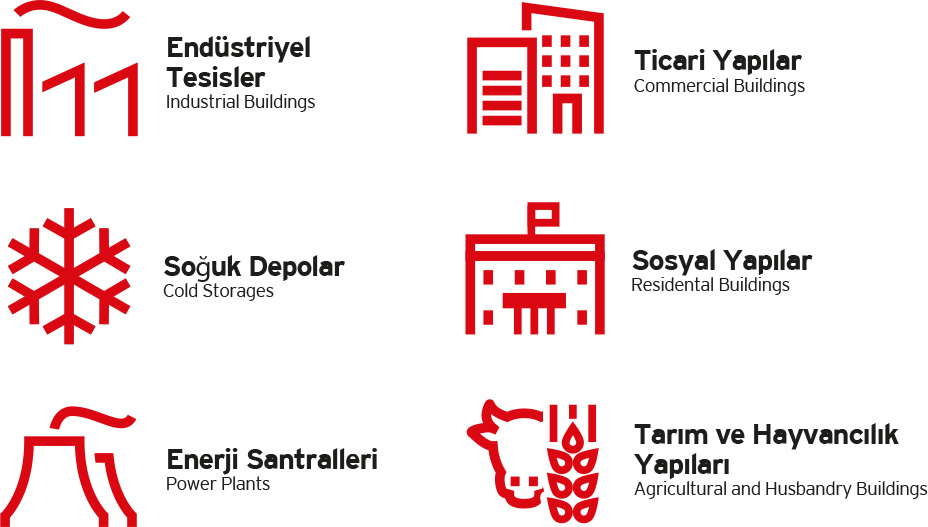
Sandwich Panel Advantages
Fast and Easy Installation
Contrary to the traditional systems, continuous line manufactured sandwich panels are in fully compatible and ready to assemble pieces that are prepared in the required dimensions, insulation types and colors based on the structure of your facility, with engineering and quality control processes conducted beforehand at the factory.
Installation of the sandwich panels is very easy with the few joints on wide surfaces. By means of advanced transport opportunities and mechanical lifting equipment, the duration of carrying and cladding is remarkably shortened. Therefore, your project is delivered in a short span of period, allowing you to save time.
Perfect Thermal Insulation
Thermal insulation means reducing the energy spent in winter for warming and in summer for cooling; and taking measures to prevent heat transmission with the objective to live in comfortable environments. Sandwich panel is a building material, which is very suitable for thermal insulation.
Sandwich panel provides high thermal insulation by means of PUR, PIR, EPS and Mineral Wool insulation materials. Thermal insulation with sandwich panels prevents problems such as mold and humidity resulting from heat movements and condensation, and ensures your building to be robust and long-lasting. Thickness of the insulation material in the sandwich panel varies according to the load bearing capacity, regional conditions, the usage purpose of the building, and the thermal insulation value.
Investment Economy
In many types of buildings, you can save up on both building and installation time by selecting the appropriate sandwich panel. Thanks to its feature of easy mounting, you can conduct expansion and renovation works without interrupting everyday activities in the building. Moreover, the panels are both economic and practical as they can be disassembled and reused.
The lightness of sandwich panels allows you to gain advantage with regards to transport and main building costs. Also, their maintenance costs are low thanks to their durable structure.
In brief, sandwich panel is both a fast and aesthetic solution and budget-friendly for its longevity.
Aesthetic Appearance of Your Buildings
The outlook of your building is just like the mirror of your dreams. That is why we add new ideas to our sandwich panels every day for the aesthetic of your buildings. You can enliven the outer walls of your building and obtain an aesthetic appearance with the sandwich panels designed in different colors and in a structure that enables them to be positioned horizontally, vertically or angular. Thanks to their feature to be used in the internal sections as well, you can create different designs with the sandwich panels.
High Fire Resistance
If you choose a sandwich panel fit for your building in terms of fire insulation, you will be able to slow down the spreading of fire within the building and its surroundings, and to ensure the safety of life and property in the building.
While choosing sandwich panels for fire insulation, you should take into consideration the factors such as fire resistance and its duration, as well as the size and height of your building, and prefer sandwich panels with Mineral Wool or FM-approved PIR-cores.
Air and Water Tightness
Thanks to their perfect joint detail, Teknopanel sandwich panels prevent air and water leakage. While they ensure the continuity of thermal insulation, heat is not lost at any point of your building. Therefore, you take the heating and cooling in your building under control and ensure energy efficiency.
With a watertight structure, sandwich panels ensure active hydro-insulation against natural conditions such as snow and rain, and prevent humidity and mold. As they hinder corrosion on the load-bearing structures, they provide a healthy and comfortable environment in your building. Your building becomes stronger and more durable.
Noise-Free Buildings
Sound insulation is a must in order to minimize the harmful effects of noise on humans, to leave out the unwanted sounds, and to reduce the sound spreading around from noisy areas.
With their mineral wool insulation core and perforated sheet metal surface that lead to sound insulation features, acoustic sandwich panels used on the roof and walls increase productivity by creating healthy and comfortable spaces free from noise and prevent workplace accidents.
Sandwich Panel Insulation Type Selection Guide
The function and needs of every building are different. Sandwich panel choice thus varies according to thermal, acoustic and hydro insulation and fire resistance needs of your building. Selecting the insulation core in accordance with the need of your building positively affects the performance you will obtain from the sandwich panel.
You can select the insulation material suitable for the features and needs of your building from the Sandwich Panel Selection Table we prepared for you.

Polyurethane (PUR)
Polyurethane is the rigid foam formed by mixture of main components ‘polyol and isocyanate’ with catalyst materials under high pressure and special production conditions.
Ensuring superior thermal insulation by its closed cell structure, polyurethane has high dimensional stability, and does not absorb water. It does not create bacteria. Its mechanical performance is very high thanks to its high compressive strength.
Polyisocyanurate (PIR)
A new macromolecular structure called polyisocyanurate is formed when the main components of the polyurethane foam chemically react at different mixture quantities. Polyisocyanurate rigid foam is the version of polyurethane with higher, enhanced fire resistance performance due to the difference in its structure. In case of a fire, the formation of smoke is very low when compared to polyurethane.
Mineral Wool
Mineral wool is the general name given to the fibers obtained by melting the inorganic rocks and other inorganic oxides at a high temperature. With its fibrous and open cell structure, mineral wool is the perfect choice for your building with regards to sound insulation and fire resistance. When it comes to thermal insulation, it has a lower insulation value compared to PUR and PIR.
Mineral wool in sandwich panels is sliced in our fully automatic production facilities, and their fibers are used in a position perpendicular to the panel surface. Therefore, the resistance of the panel against pressure is increased and its mechanical value is improved.
You may prefer to use the mineral wool insulation material especially for buildings that require high sound insulation or those under fire risk or for any building, where flammable/explosive materials are stored.
Expanded Polystyrene (EPS)
Expanded polystyrene is a thermoplastic material, a derivative of petroleum. The raw material of polystyrene, which has a micro-granular structure, is firstly heated and expanded with water vapor. Pentane gas, an organic component, is used to inflate the granules. After inflation process, the polystyrene granules stick firmly to one another and take the shape of the mold they are in. Finally, after having been shaped into blocks, expanded polystyrene is ready to use by cutting into sheets.
At the end of this process, pentane gas replaces air. This motionless and dry air, which is trapped in the granules with small closed pores, enables EPS sheets to provide superior thermal insulation for your buildings.
EPS is the most economic and lightweight product among all types of thermal insulation.
Sandwich Panel Coating and Colour Selection
Inner and outer sheet features of sandwich panels shall be determined according to the environmental conditions your building may be exposed to.
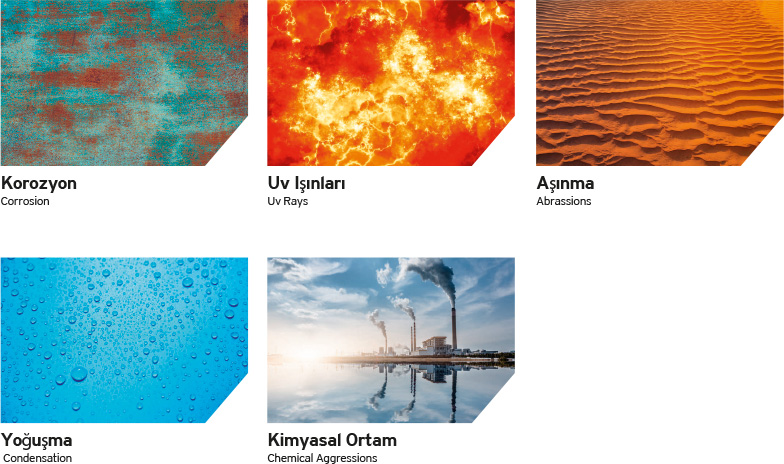
• Natural or prepainted aluminum and stainless steel
Prepainted Galvanized Steel Coating Layers
Prepainted Galvanized Steel Production Stages
The sheet galvanized by being coated with a zinc layer between 100 gr/m2 - 275 gr/m2 by using the hot dipping method is produced on highly automated continuous lines called coil coating.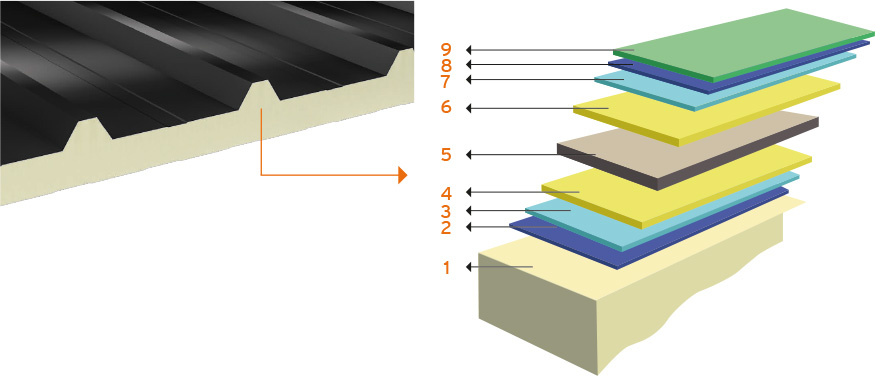
- 1. Insulation Core
- 2. Backcoat
- 3. Passivating Layer
- 4. Galvanisation
- 5. Steel
- 6. Galvanisation
- 7. Passivating Layer
- 8. Coat
- 9. Topcoat
Coating Colors
RAL color chart is referenced while determining the colors in prepainted galvanized sheet production. You can see in the table below the standard polyester prepainted sheet colors used by Teknopanel on their sandwich panels.
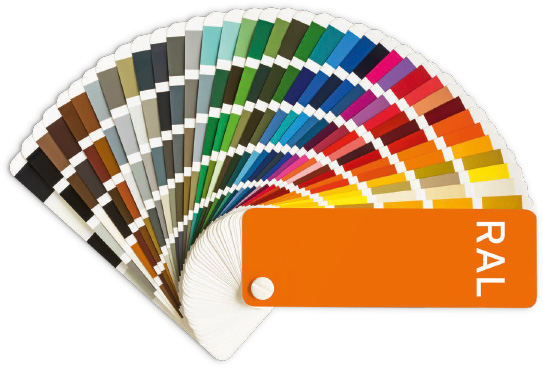
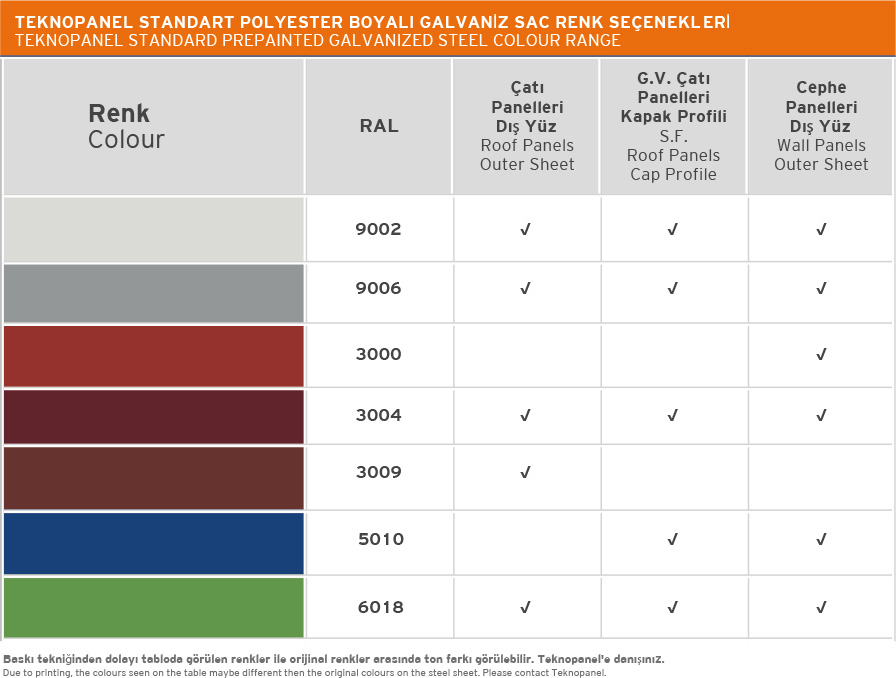
Coating Type And Specification
Teknopanel offers various coating alternatives for you to use for sandwich panels based on the location and needs of your building.
Polyester Coatings
Thanks to their variety of color and gloss options and being an economic solution, the usage areas of polyester coatings are very wide. Moreover, polyester coatings are highly resistant towards flexibility, abrasion, corrosion, humidity, and impact. The application thicknesses vary between 20-25 μm and 60 μm according to the place of usage andthe expected performance.
PvDF Coatings
The strongest feature of PvDF coatings is that their resistance towards color, gloss, chalking, and many chemicals is high. Moreover, their resistance towards impact and abrasion, as well as their flexibility is very good. On the other hand, PvDF coatings are less scratch resistant, and their color and gloss options are limited when compared to polyester coatings. Application thicknesses vary between 25 μm and 28 μm.
Polyurethane CoatingsPolyurethane coatings become highly scratch and friction resistant with polyamide reinforcement, they can be applied in flat and patterned forms. They are highly corrosion, color and gloss resistant, and highly shapeable. Their widespread application thicknesses vary between 20 and 25 μm. However, they are suitable for thicker applications as well.
Plastisol Coatings
Plastisol coatings have higher application thicknesses when compared to other coating types. Dry film thicknesses varying between 100 and 120 μm are widely used. Their strongest feature is high corrosion and humidity resistance. Moreover, they are suitable for embosser application. On the other hand, plastisol coatings are less color and gloss resistant when compared to other coating types. That is why they are preferred in cold storage applications or cold and humid climate conditions in which sun rays are not too effective and UV resistance is not crucial.
PVC Films
PVC films are used in indoor or outdoor applications as laminated on aluminium or galvanized steel surfaces. They are particularly preferred in cold storage applications with their high resistance to corrosion and humidity. Depending on the place and purpose of use, the thickness can vary between
120 μm – 800 μm. They provide an aesthetic appearance with their various texture alternatives
You can choose from the table below the coating type for the sandwich panels you will use on your building depending on the environmental conditions.
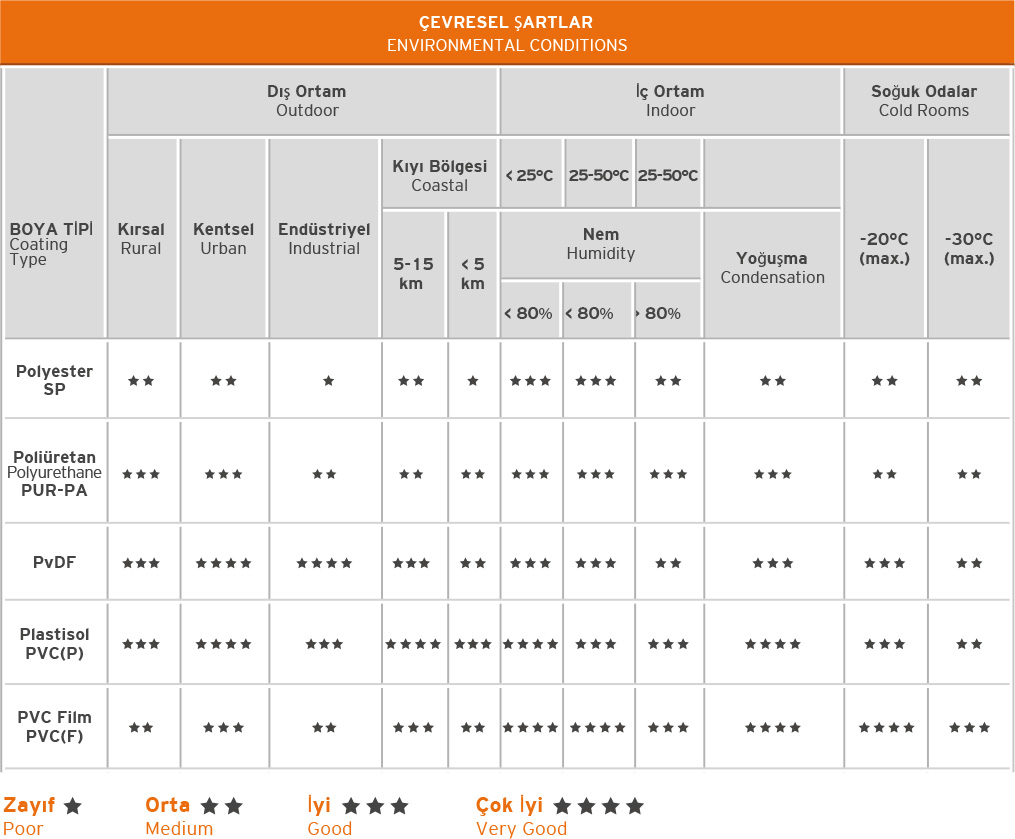
Sandwich Panel Prices
Sandwich panels, which are produced at Teknopanel production facilities as ready-assembled and in line with the features of your projects, provide advantages such as ensuring thermal, humidity and acoustic insulation, and waterproofing; increasing the fire resistance; and giving an aesthetic appearance while it also allows you to make a profitable investment by decreasing the shipping, transportation, installation, labor expenses and periods greatly in terms of price/cost in accordance with the implementation of panels with on-site application.
When the sandwich panel prices are determined, the metal type of inner and outer sheet, metal thickness, dye type and color, insulation core type and thickness are taken into consideration along with the total order amount.
- Roof Panel Prices
Sandwich panels are among the construction materials frequently used for the roofs of different buildings. Sandwich roof panels are among the roof products with the highest price/performance rate since they ensure thermal-humidity insulation and waterproofing. Different insulation materials such as PUR/PIR, Mineral Wool, and EPS can be used in insulation for sandwich roof panels. Teknopanel sandwich roof panels provide various product options such as membraned, with GRP in forms of 3 ribs and 5 ribs in standard and secret fix junction details.
Sandwich roof panels vary depending on their usage areas and unique needs. Sandwich roof panel prices vary according to different criteria such as product volume, density, thickness, and material type in line with the technical specifications of your project.
- Wall Panel Prices
Sandwich wall panels are used in the formation of both inner and outer walls of buildings to ensure the maximum performance in thermal insulation. Wall panel prices vary depending on the inner and outer sheet metal type, metal thickness, dye type and color, insulation core type and thickness, and the total order amount as in prices of roof panels.
It coats the building walls with a proper installation and provides thermal insulation at the same time. It is long lasting thanks to its durable nature. Sandwich panels having a wide range of usage area from factories to malls, storages to agriculture and husbandry buildings, and even to power plants are among the most economic materials. Wall panels add architectural value to the projects with their different surface patterns such as micro, deep lined, and sinus alongside their standard or secret fixed joint details.
- Cold Storage Panel Prices
Sandwich panels are used as cold storage panel in buildings such as cold rooms and cold storages which requires certain air-conditioning features, based on their thermal insulation feature. Cold storage panels maintain the desired temperature and control the heating and cooling process. PUR/PIR insulation types are used in cold room panels while different materials such as pre-painted galvanized sheet, stainless steel, ad PVC lamination can also be preferred.
Cold storage panel prices are determined according to the technical specifications of the required panels based on the usage requirement. Please contact us to select the cold room panel according to your need and receive information about cold room panel prices.
- Acoustic Panel Prices
Sandwich panels are used for thermal-humidity insulation and waterproofing, they can be used as acoustic panels to ensure sound insulation. Acoustic sandwich panels, with their rock wool insulation material and perforated surface, have high acoustic performance and sound absorber feature. It keeps noise under control at industrial facilities while ensuring acoustic insulation at social areas such as fitness centers and cinema halls. The prices of acoustic panels, which can be easily installed to walls and ceilings of indoors alongside the roofs and walls of buildings, vary depending on factors such as product features, length and thickness.
You can get information about product features by visiting our sandwich panel websites and place order by filling the information form.
You can call us from +90 0850 777 0850 contact number to receive information on sandwich panel sizes, and sandwich panel m2 price.

